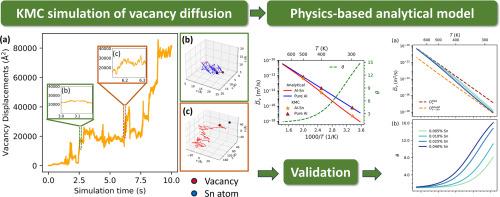Revisiting the vacancy diffusion behavior under the influence of solute trapping in dilute alloys
IF 8.3
1区 材料科学
Q1 MATERIALS SCIENCE, MULTIDISCIPLINARY
引用次数: 0
Abstract
Vacancies play crucial roles in various phase transformation processes in metallic solids, but their diffusion behaviors in the presence of solute elements are less known. In this work, the impacts of substitutional solute atoms on vacancy diffusion in dilute alloys are quantitatively studied. Using Al-Sn alloy system as an illustrative case, the detailed vacancy diffusion behavior under the influence of Sn atoms is revealed by atomistic kinetic Monte Carlo (KMC) simulations. Accordingly, a physics-based analytic model is derived to quantify the influences of substitutional solute atoms on the vacancy diffusivity in dilute alloys. In the model, the diffusion of vacancy is rigorously treated as a combination of free diffusion within host atoms and co-diffusion together with solute atoms. Based on the vibrational frequency, migration enthalpy and binding energy of solute-vacancy pair obtained from first-principles calculations, the time fraction for a vacancy trapping by solute atoms and the corresponding correlation factor of diffusion are derived. The predicted vacancy diffusivity in the show-case Al-Sn alloys at different temperatures shows a good agreement with the diffusivity data extracted from KMC simulations within the five-frequency model framework. By using the analytical model, the trapping effects of different impurity elements on vacancy diffusion in Al alloys are screened and discussed, which will help to further exploit the influences of different solute atoms on vacancies in solid-state phase transformations in the alloys.

求助全文
约1分钟内获得全文
求助全文
来源期刊

Acta Materialia
工程技术-材料科学:综合
CiteScore
16.10
自引率
8.50%
发文量
801
审稿时长
53 days
期刊介绍:
Acta Materialia serves as a platform for publishing full-length, original papers and commissioned overviews that contribute to a profound understanding of the correlation between the processing, structure, and properties of inorganic materials. The journal seeks papers with high impact potential or those that significantly propel the field forward. The scope includes the atomic and molecular arrangements, chemical and electronic structures, and microstructure of materials, focusing on their mechanical or functional behavior across all length scales, including nanostructures.
 求助内容:
求助内容: 应助结果提醒方式:
应助结果提醒方式:


